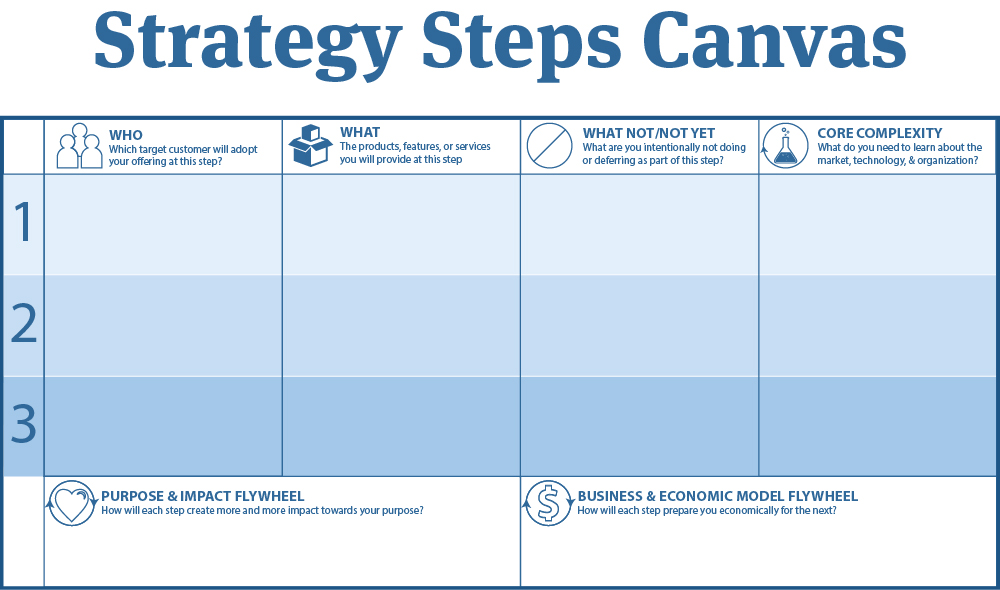In larger orgs, the Product Owner (PO) role is often split between more than one person. We can have a separate conversation about whether that’s a good idea and how to cope with it (in fact, we did a whole meetup session on the topic).
In any case, one common effect of a split PO role are POs in our workshops saying, “Product strategy isn’t my responsibility. Someone else does that, and I just manage backlog items.”
While POs may not be creating the strategy, we believe every PO has a role when it comes to product strategy.
What Is Strategy?
Product strategy sits between product vision and the product backlog. It’s connective tissue. While vision describes the world for your customers once your product is successful, strategy captures the high level steps you’ll take to reach that vision. A strategic step often involves adding a new target market, doing a new customer job for an existing one, or adding a significant set of capabilities to drive a business outcome that wasn’t possible before. The strategy provides a high level filter on choices you’ll make when adding and ordering items in the product backlog.
Visualize It & Use It
Perhaps you don’t feel like you have much control over or even influence on strategy. It’s still an important part of your role. At minimum, every PO should take ownership for making product strategy visible to their team and using it to inform the shape of the backlog.
If you don’t own product strategy but the person who does own it hasn’t given you an artifact that summarizes your strategy, create a visual of what you understand it to be. You may only have a hypothesis of what the strategy is, and that’s ok. Take a shot at making that visible.
You can use Humanizing Work’s Strategy Steps Canvas (download here), which we teach in our Advanced CSPO and leadership courses, or any other approach that helps you communicate long term goals effectively to the team, and filter and focus effectively in your backlog.
Influence It
Once you’ve visualized the strategy for your team, invite your leaders to adjust and correct your visual. You’ll end up with more alignment and something you can use with your team to connect everyday work to larger outcomes.
POs who visualize an implicit strategy often find it’s not nearly as defined as they may have assumed. Creating the visual often gives you a seat at the table to weigh in on the strategy. Use your experience to influence the strategy in a healthy direction, even if that’s just asking questions to flesh it out and test it.
Create It
Strategy can mean a lot of different things and can be created using various techniques. Here’s how we boil it down: Your strategy is a handful of big steps between today and a future described in a vivid vision, along with enough context to explain why those steps and why that order.
If you set the direction for a product, a business unit, or an organization, create a vision statement that captures the better future your team’s work will create when you’re successful. (Check out this recent Humanizing Work Show episode for some tips on creating a vision statement that’s not boring, corporate-speak.)
Then, sketch out the 3-5 big steps between your current state and that vision. Ideally, each of those steps will resolve some complexity, have some real impact, and give you more resources for the next step (revenue, credibility, collaborators, etc.).
Use your vision and strategy to shape your team’s work. Connect the day-to-day to the larger strategic steps and the strategic steps to the larger vision.
Learn More
Want to get better at creating and using a product strategy?
Next week is our next public Certified Scrum Product Owner (CSPO) workshop, which dives into how to take a big idea (like a vision or a big strategic step) and slice it into a great backlog so your team is adding value every day.
And just a couple weeks later, we kick off our May cohort of our Advanced CSPO program. In this 6-week program, you’ll learn how to do customer research, test product assumptions, and discover the right strategy for your product.
Resources
Download the Strategy Steps Canvas
Last updated
